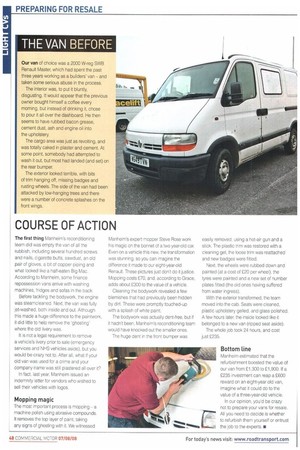COURSE OF ACTION
Page 38

If you've noticed an error in this article please click here to report it so we can fix it.
The first thing Manheim's reconditioning team did was empty the van of all the rubbish, including several hundred screws and nails, cigarette butts, sawdust, an old pair of gloves, a bit of copper piping and what looked like a half-eaten Big Mac. According to Manheim, some finance repossession vans arrive with washing machines, fridges and sofas in the back.
Before tackling the bodywork, the engine was steamcleaned. Next, the van was fully jet-washed, both inside and out. Although this made a huge difference to the paintwork, it did little to help remove the 'ghosting' where the old livery was.
It is not a legal requirement to remove a vehicle's livery prior to sale (emergency services and NHS vehicles aside), but you would be crazy not to. After all, what if your old van was used for a crime and your company name was still plastered all over it?
In fact, last year, Manheim issued an indemnity letter for vendors who wished to sell their vehicles with logos.
Mopping magic
The most important process is mopping a machine polish using abrasive compounds. It removes the top layer of paint, taking any signs of ghosting with it. We witnessed Manheim's expert mapper Steve Rose work his magic on the bonnet of a two year-old car. Even on a vehicle this new, the transformation was stunning, so you can imagine the difference it made to our eight-year-old Renault. These pictures just don't do it justice. Mopping costs £70, and, according to Grace, adds about £300 to the value of a vehicle.
Cleaning the bodywork revealed a few blemishes that had previously been hidden by dirt. These were promptly touched-up with a splash of white paint.
The bodywork was actually dent-free, but if it hadn't been, Manheim's reconditioning team would have knocked out the smaller ones.
The huge dent in the front bumper was easily removed, using a hot-air gun and a stick. The plastic trim was restored with a cleaning gel, the loose trim was reattached and new badges were fitted.
Next, the wheels were rubbed down and painted (at a cost of £20 per wheel), the tyres were painted and a new set of number plates fitted (the old ones having suffered from water ingress).
With the exterior transformed, the team moved into the cab. Seats were cleaned, plastic upholstery gelled, and glass polished. A few hours later, the inside looked like it belonged to a new van (ripped seat aside).
The whole job took 24 hours, and cost just £235.
Bottom line
Manheim estimated that the refurbishment boosted the value of our van from £1,300 to £1,900. If a £235 investment can reap a £.600 reward on an eight-year old van, imagine what it could do to the value of a three-year-old vehicle.
In our opinion, you'd be crazy not to prepare your vans for resale. All you need to decide is whether to refurbish them yourself or entrust the job to the experts..


























































































































































